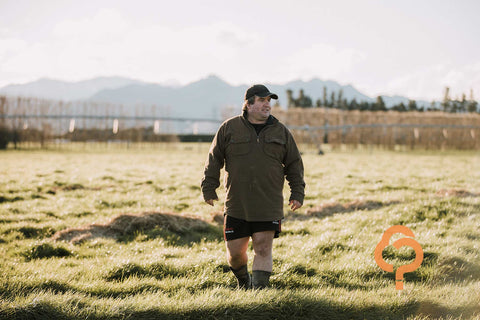Once you've hit your target soil test levels, how much fertiliser do you need to keep things steady?
This is a common and important question, so here’s some assistance working it all out. The situation is different depending on whether you’re a sheep and beef (or deer) farm, or a dairy outfit – so we’ve broken down both.
Then, once you’ve tested your soil and understand the principles below, you can use our FertSearch calculator to work out the right products for your land.
Firstly - what do we mean by ‘maintenance’ fertiliser?
Maintenance fertiliser keeps your soil at its current nutrient levels, just topping up what gets used by grazing animals (or crops) each season to keep it balanced and dependable.
This is different to the term ‘capital’ fertiliser, which is about boosting nutrient levels significantly when your soil is lacking, aiming to improve your overall soil fertility.
Thanks to in-depth pasture growth trials, we've figured a range for how much phosphate (P), potassium (K), and sulphur (S) you need for to maintain soil fertility on most NZ farms annually:
- Phosphate (P): 5-50 kg/ha
- Potassium (K): 0-60 kg/ha
- Sulphur (S): 5-40 kg/ha
But hold on, you say. This is a huge range!
The essential detail lies in your stock rates, soil type, farming system and a number of other factors. We’ve provided some data for you to gage a more accurate assessment after robust soil testing below.
Important: using the data in this article is not an exemption from soil testing, but to support your testing programme. View our range of soil testing kits here.
Sheep, beef and deer farms
Let’s look at stocking rates first, and then other factors (below) of soil type, rainfall and typography.
Maintenance nutrient requirements (kg/ha) to stocking rate:
Stocking rate (SU/ha) |
Maintenance rate (kg/ha) |
||
|---|---|---|---|
| P | K* | S | |
| 7 | 6-18 | 0-21 | 6-19 |
| 10 | 10-22 | 0-28 | 8-25 |
| 13 | 15-28 | 0-35 | 10-29 |
| 16 | 21-34 | 0-41 | 13-33 |
| 19 | 28-41 | 0-48 | 15-37 |
| 22 | 34-44 | 0-54 | 17-41 |
*K can be supplied by clay minerals on some sedimentary soils (eg recent, Pallic soils) so there is no immediate requirement for K. In this situation, K reserves will become depleted and K fertiliser will be required in the future. Where hay and silage crops are removed an additional 15-20 kg K per tonne of dry matter removed should be applied on all soils.
Also consider soil type, topography and rainfall
When it comes to sheep, beef and deer, in addition to stocking rate, maintenance nutrient requirements also vary according to other factors including soil type, topography and rainfall.
Location |
Farm type |
SU/ha |
Soil |
Topography |
Rainfall (mm/yr) |
P |
K |
S |
|---|---|---|---|---|---|---|---|---|
kg/ha/yr |
||||||||
| Waikato | Beef/heifer grazing | 22 | Ash | Flat | 1000 | 36 | 30 | 30 |
| Waikato | Sheep/beef | 16 | Ash | Easy | 1000 | 30 | 25 | 26 |
| Central Plateau | Beef/heifer grazing | 19 | Pumice | Rolling | 1200 | 34 | 26 | 30 |
| Central Plateau | Sheep/beef | 14 | Pumice | Easy | 1200 | 28 | 22 | 24 |
| Hawkes Bay | Sheep/beef | 13 | Sedimentary | Rolling | 1100 | 20 | 0 | 18 |
| Wairarapa | Sheep/beef | 10 | Sedimentary | Steep | 1100 | 18 | 0 | 17 |
| North Canterbury | Sheep | 8 | Sedimentary | Steep | 700 | 10 | 0 | 9 |
| Mid Canterbury | Sheep* | 16 | Sedimentary | Flat | 1200 | 23 | 0 | 20 |
| Southland | Sheep | 15 | Sedimentary | Flat | 800 | 21 | 20 | 17 |
| Southland | Deer | 15 | Sedimentary | Flat | 800 | 21 | 20 | 17 |
*Border irrigated
(Although nutrient rates have been calculated to maintain near maximum pasture production in the above table, requirements for lower pasture production have not been determined).
As an alternative, here’s a general rule-of-thumb for P, K and S on sheep, beef and deer farms:
- Apply 15-20 kg/ha Superphosphate or equivalent per SU wintered.
- Where K or elemental S is required these should be added to the above e.g. 20-25 kg 15% Potash Super or equivalent per SU wintered.
Dairy
You’ll need to consider stocking rates, and then other factors (below) of soil type, and the production of milk solids.
Maintenance nutrient requirements (kg/ha/yr) in relation to dairy stocking rate:
Stocking rate (cows/ha)* |
Maintenance rate (kg/ha) |
||
|---|---|---|---|
| P | K | S | |
| 2 | 29-47 | 20-50 | 10-23 |
| 2.5 | 33-51 | 25-58 | 13-30 |
| 3 | 37-55 | 40-70 | 16-35 |
| 3.5 | 41-59 | 50-82 | 19-40 |
| 4 | 45-63 | 60-95 | 22-45 |
*1 cow at 460kg liveweight producing 375 kg milk solids/yr
Also consider topography, soil type and production of milk solids/ha.
Maintenance requirements for P, K and S have been calculated for dairy farms on ash and sedimentary soils, with average milk solids production/ha.
Input data and predicted requirements are shown in this table (as a guide only):
Parameter |
Ash soil |
Sedimentary soil |
|---|---|---|
| Slope | Flat | Flat |
| Olsen P | 30 | 30 |
| Soil organic-S | 10 | 6 |
| S applied last 2 yrs (kg/ha) | 50 | 50 |
| Quick test K | 7 | 7 |
| Reserve K | Very low | Low |
| K leaching | High | High |
| Rainfall (mm) | 1000-1500 | 1000-1500 (includes irrigation) |
| MS (kg/ha/yr) | 1000 | 1000 |
| Stocking rate (cows/ha) | 2.7 | 2.6 |
Based on these scenarios, the maintenance requirements (in kg/ha) across the two soil orders are calculated as follows:
Parameter |
Ash soil |
Sedimentary soil |
|---|---|---|
| P | 38 | 30 |
| K | 64 | 32 |
| S | 25 | 30 |
In this example, the soil test results are within the target range for Olsen P and QTK, and below the target range for organic-S for sedimentary soils. The calculated maintenance rates will maintain near maximum pasture production provided that an effective S fertiliser programme is employed. There is no financial advantage in increasing soil P, K, S values further by applying higher rates of fertiliser nutrients.
In the absence of more detailed modelling or product removal estimates, this general rule-of-thumb can be used:
- Volcanic ash and pumice soils: Apply 0.6 to 0.8 kg/ha 20% Potash Super or equivalent for every 1 kg/ha milk solids produced.
- Sedimentary soils: Apply 0.5 to 0.7 kg/ha 15% Potash Super or equivalent for every 1 kg/ha milk solids produced.
Ready to choose the right fertiliser products?
If you’re armed with your soil testing results and are comfortable with your maintenance nutrient requirements by looking at the data, jump onto our tool Fertsearch – to help you choose the right mix of products.
Find the right products with FertSearch
How do you know if your maintenance programme is working?
An increasing soil test result trend over time without an increase in pasture production indicates that the rate of nutrient application has been too high. A declining trend suggests that insufficient nutrient is being applied to maintain existing production.
If your soil test results are constant over several years, the nutrient application rate over this period will be on the money.
It’s all about playing the long game. To gather the most accurate info, you’re best to monitor soil nutrient levels over the long term and adjust your fertiliser programme as you go.
If you need extra help we recommend calling a qualified nutrient management adviser with access to tools such as OverseerFM, who will model the nutrient cycle on the farm and help to balance the use of P, K, S and lime.
Discover more of our informative articles or to place an order, explore our Fertiliser range. If you need more information, leave us a message or call 0800 479 469 (0800 GRWHOW).

